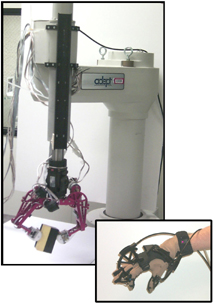|
|
|
|
|
|
The human interface consists of three parts: the CyberGlove® which measures
the joints of the hand, the CyberGrasp® also from Immersion
Corporation (formerly sold by Virtual
Technologies) which applies forces to the human fingertips and an ultrasonic
system tracks the operator's arm wrist position. The robot systems consists
of a dexterous robot hand (Dexter) connected
to an Adept 1 robot.
The CyberGlove®, is a right handed
glove with 22 bend sensors measuring each of the joints of the hand. The resolution
on each sensor is 0.2° to 0.8° depending on the particular joint?s
range of motion. By reading only the appropriate sensors for the thumb and
index finger, data collection can be run at 200 Hz. The glove is calibrated
for each individual user. A predictive algorithm is used so the data appear
to be continuous at 1000 Hz, and are used in robot control.
 Force
feedback is provided to the user's fingertips through the CyberGrasp®
mechanism, a cable driven device designed for use with the CyberGlove. A set
of motors, worn in a backpack, apply tension to cables in teflon sheaths,
which in turn apply forces to each finger. The forces applied to the finger
are unipolar, since the cable can only pull along a single axis, and are grounded
to the back of the hand, so no forces restrain arm motion. The motors can
apply force up to 12 N and are updated at 1000 Hz to appear smooth and continuous
to the user. The system has a resonance in the range of 20 Hz and a cutoff
frequency on the order of 40 Hz. Force
feedback is provided to the user's fingertips through the CyberGrasp®
mechanism, a cable driven device designed for use with the CyberGlove. A set
of motors, worn in a backpack, apply tension to cables in teflon sheaths,
which in turn apply forces to each finger. The forces applied to the finger
are unipolar, since the cable can only pull along a single axis, and are grounded
to the back of the hand, so no forces restrain arm motion. The motors can
apply force up to 12 N and are updated at 1000 Hz to appear smooth and continuous
to the user. The system has a resonance in the range of 20 Hz and a cutoff
frequency on the order of 40 Hz.
The motion of the user's arm is measured
by a six degree of freedom ultrsonic
tracking system. The system has a positional resolution of 0.1mm and
an angular resolution of 0.1 degree. Accuracy is 2% of the distance from
the transmitter. Tracking space is approximately a 2.3 m long 100 degree
cone. The tracking information is updated at 50 Hz and then transformed
and filter before being send to the Adept robot via an ethernet connection.
Attached to the Adept robotic arm is, Dexter,
a two-fingered robotic hand, with two degrees
of freedom per finger. The motors are fairly small, due to weight and space
limitations, but are still capable of providing enough force at the fingertips
to pick up a 250g object, such as a softball, which more than suffices for
the purpose of these experiments. The links are 100 mm long, and each has
over 120° of motion. The workspace of the hand is about 400 mm by 150
mm, with a positional resolution of 0.08 mm. This workspace is sized to best
manipulate objects from about one to three inches in diameter. Manipulation
is not limited to spherical objects; the telemanipulation
tasks involve manipulation of square blocks and cylindrical objects. Two-axis
strain gage force sensors have been incorporated into the robot fingertips
to read the forces applied by the robot to the object. The robot hand is placed
on the end of an Adept 1, a 5 DOF SCARA
industrial robot arm. The Adept has a positional resolution of 0.04 mm and
0.05° in the rotational axis. The workspace is approximately 1100 mm long
by 350 mm wide by 175 mm high. The robot trajectory is controlled by the Adept
controller utilizing the enhanced trajectory controller (V+ ver 14). |

 Force
feedback is provided to the user's fingertips through the CyberGrasp®
mechanism, a cable driven device designed for use with the CyberGlove. A set
of motors, worn in a backpack, apply tension to cables in teflon sheaths,
which in turn apply forces to each finger. The forces applied to the finger
are unipolar, since the cable can only pull along a single axis, and are grounded
to the back of the hand, so no forces restrain arm motion. The motors can
apply force up to 12 N and are updated at 1000 Hz to appear smooth and continuous
to the user. The system has a resonance in the range of 20 Hz and a cutoff
frequency on the order of 40 Hz.
Force
feedback is provided to the user's fingertips through the CyberGrasp®
mechanism, a cable driven device designed for use with the CyberGlove. A set
of motors, worn in a backpack, apply tension to cables in teflon sheaths,
which in turn apply forces to each finger. The forces applied to the finger
are unipolar, since the cable can only pull along a single axis, and are grounded
to the back of the hand, so no forces restrain arm motion. The motors can
apply force up to 12 N and are updated at 1000 Hz to appear smooth and continuous
to the user. The system has a resonance in the range of 20 Hz and a cutoff
frequency on the order of 40 Hz.